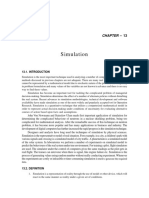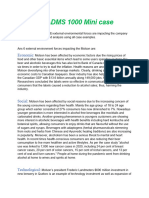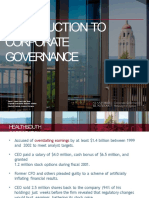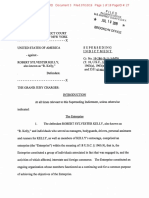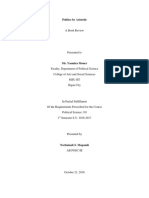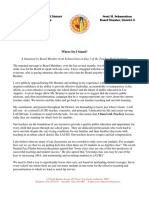Chapter5 Summary CSR
Chapter5 Summary CSR
Uploaded by
Abid IqbalCopyright:
Available Formats
Chapter5 Summary CSR
Chapter5 Summary CSR
Uploaded by
Abid IqbalOriginal Description:
Copyright
Available Formats
Share this document
Did you find this document useful?
Is this content inappropriate?
Copyright:
Available Formats
Chapter5 Summary CSR
Chapter5 Summary CSR
Uploaded by
Abid IqbalCopyright:
Available Formats
Part 2: Chapter Objectives, Summarizing Outlines, And Case Notes
Corporate Social
Responsibility
LEARNING OBJECTIVES
The definition of corporate social responsibility.
How the idea of corporate social responsibility has evolved, broadening over the years.
To understand the arguments of opponents of corporate social responsibility.
General principles of corporate social responsibility.
What studies show about the relationship between social and financial performance in firms.
About the rise of a global CSR system based on civil regulation.
To understand eight principle components of the global CSR system.
How ideas about corporate responsibility in the chapter apply to General Electric Company.
SUMMARIZING OUTLINE
This chapter introduces the idea of corporate social responsibility and follows its evolution
from colonial America to its present expansion into the global business arena. The opposition
of critics and managers who defy the idea in practice is explained. General principles of
corporate social responsibility are set forth. The relationship between social and financial
performance is discussed. A section is devoted to the rise of a global system of civil
regulation to prompt CSR in multinational corporations. Illustrations of how CSR is
encouraged by 8 major elements of this system are given.
The introductory story is about Merck & Co., Inc.
Merck spent more than $200 million developing a drug treatment for river
blindness, a disease endemic in underdeveloped nations, although neither
patients nor international organizations could or would pay for it.
Since 1987 Merck has given away more than 1.4 billion doses of ivermectin,
mostly in Africa, at a cost of $2.1 billion. The medicine has saved hundreds of
thousands of people from blindness and helped the economies of African
nations.
The story is an outstanding example of how some corporations accept the
idea of corporate social responsibility and go beyond normal market
operations, acting to improve society in some way.
Corporate social responsibility, or CSR, is the duty a corporation has to create
wealth in ways that avoid harm to, protect, or enhance societal assets. The idea has
expanded in meaning over time.
5
Part 2: Chapter Objectives, Summarizing Outlines, And Case Notes
Advocates of CSR justify it with two arguments.
It is a moral duty to promote social justice.
It has concrete benefits such as creating loyal customers.
Opponents of CSR have several arguments against it.
It imposes costs that make corporations less efficient, thus
subtracting from overall social welfare.
It is unfair to shareholders because managers divert profits that
belong to them to social projects.
Libertarians are advocates of laissez-faire, who believe that the
market allocates resources more efficiently than political pressures.
They oppose CSR because they believe its advocates are
predominantly progressives with a leftist policy agenda.
The meaning of corporate social responsibility has evolved.
In classical economic theory a business was socially responsible if it
maximized profits while operating within the law.
In colonial America merchants were thrifty, but charity was a coexisting virtue
and business owners gave to churches, orphanages, and poorhouses.
In the early 1800s wealthy entrepreneurs such as Steven Girard began to
give large gifts and bequests to schools and other worthy causes.
They were followed by entrepreneurs who made fortunes during the economic
growth of the late 1800s. John D. Rockefeller and Andrew Carnegie are
examples of industrialists who turned into great philanthropists.
The rise of social Darwinism in the last half of the nineteenth century braked
expansion of the social responsibility idea. Popularized by Herbert Spencer,
social Darwinism held that charity, which supported weaker and less
successful individuals, ran contrary to the harsh reality of evolution. And it was
evolution, not soft-headed benevolence, that brought progress. Social
Darwinism justified ruthless, predatory competition.
Early in the twentieth century three interrelated ideas emerged to justify
broader corporate responsibility.
Managers were trustees, or agents of corporate power whose
positions implied a duty to protect stakeholders.
Managers had an obligation to balance the multiple interests of
stakeholders.
Part 2: Chapter Objectives, Summarizing Outlines, And Case Notes
The service principle was a near-spiritual belief that individual
managers served society by building successful businesses. The
prosperity they created would eradicate broad social ills such as
poverty.
Not everyone subscribed to these expansions of the social
responsibility doctrine. Henry Ford, for example, ruthlessly maximized
profits at the expense of workers. But others such as General Robert
E. Wood of Sears, Roebuck accepted expanding duties toward
society.
An early statement of the contemporary idea of social responsibility was
Howard R. Bowens book, Social Responsibilities of the Businessman, in
1953.
Soon conservative economists such as Milton Friedman emerged with a set
of arguments against business responsibility. Friedmans basic views, as
follows, are still heard today.
The one and only responsibility of business is to make a profit because
business institutions work best responding to markets. Governments
should run social programs, not companies.
In the free enterprise system managers are responsible only to
stockholders. Spending money on social projects wrongly appropriates
money that belongs to them. It also robs consumers, who must pay
higher prices for products. This is taxation without representation.
Social responsibility threatens political freedom because it requires
that companies perform political functions, gives executives political
power, and opens business to evaluation by political criteria.
Despite Friedmans arguments the business community accepted the idea of
corporate social responsibility. Two groups of business leaders issued
supportive statements, ending major opposition.
In 1971 the Committee for Economic Development published a
report making a case for expansive social responsibility. The report set
forth three concentric circles of responsibility.
An inner circle of responsibility for economic performance.
An intermediate circle requiring exercise of the economic
function with sensitivity to social values and priorities.
An outer circle of emerging responsibilities for business to
improve the social environment broadly in ways not directly
related to its economic function.
Part 2: Chapter Objectives, Summarizing Outlines, And Case Notes
In 1981 the Business Roundtable issued a Statement on Corporate
Responsibility saying that corporations had both economic and social
duties and that there was no necessary conflict between them.
Acceptance of the doctrine of corporate social responsibility by the business
elite protected the legitimacy of large corporations. But many managers retain
a conviction that Friedman is correct and they continue to operate with an eye
only to profits.
There are three basic elements of social responsibility.
Market actions are competitive responses to forces in markets. They
dominate corporate decisions. When a corporation responds to markets, it
fulfills its first and most important social responsibility. Creating jobs, paying
taxes, and making products is the major impact of a company on society.
Mandated actions are programs required by government regulation or by
agreements negotiated with stakeholders such as unions. The importance of
mandated actions grew in the twentieth century.
Voluntary actions are those that go beyond legal, regulatory, or negotiated
mandates. A wide range of social programs and charitable activities are
included in this category.
Eight general principles of corporate social responsibility should guide managers.
First, corporations are economic institutions run for profit and should not
be expected to meet major social objectives without financial incentives.
Second, all firms must follow multiple bodies of law including (1)
corporation laws and chartering provisions, (2) the civil and criminal laws of
nations, (3) government regulations, and (4) international law.
Third, managers must act ethically.
Fourth, corporations have a duty to correct the adverse social impacts
they cause. They should internalize external costs, or costs of production
borne by society.
Fifth, social responsibility varies with company characteristics such as
size and location.
Sixth, managers should try to meet legitimate needs of stakeholders.
Seventh, corporate behavior must comply with norms in an underlying
social contract.
Eighth, corporations should accept a measure of accountability toward
society and publicly report on their market, mandated, and voluntary actions.
Part 2: Chapter Objectives, Summarizing Outlines, And Case Notes
Are social and financial performance related? Research suggests that more
responsible companies are more profitable, but methodological difficulties create
enough doubt to make reservation of final judgment wise.
Today the idea of CSR has taken on a global dimension.
While there is no consensus on its meaning and practice it is widely accepted
in developed nations and in many developing nations.
As global economic activity has expanded, transnational corporations are
perceived as eluding proper controls
International law is weak in addressing the social impacts of business.
Less developed nations sometimes have weaker regulations.
Strategies of joint venture, outsourcing, and supply chain extension
distance large corporations in developed nations from direct
accountability for social harms.
Conservative political climates in developed nations often prevent
passage of new regulations to control international business activities.
Resentment of extraterritorial jurisdiction prevents enforcement of the
more stringent laws of developed nations in less-developed nations.
To overcome these barriers to responsible corporate behavior the United
Nations has promoted new international standards for the conduct of
corporations. It has been instrumental in the development of soft law, or
statements of philosophy and principle that, over time, gain legitimacy as
guidelines for interpreting legally binding agreements.
A new system of global CSR is evolving. It is based on an evolving,
solidifying, maturing patchwork of ideas, codes, voluntary corporate actions,
and multistakeholder initiatives involving corporations, nongovernmental
organizations, and governments working together to promote a part of the
CSR agenda. There are eight major elements in this new global CSR system.
New norms and principles to direct CSR have emerged. Many are
found in declarations and codes emanating from United Nations.
Codes of conduct, or formal statements of aspirations, principles, and
guidelines for corporate behavior, have proliferated. Such codes lack
the force of law and are seen as weak unless compliance is effectively
monitored.
Reporting and verification standards have led more companies to
disclose information about their CSR performance through, for
example, sustainability reports that report progress toward
economic, social, and environmental goals.
Part 2: Chapter Objectives, Summarizing Outlines, And Case Notes
Labeling and certification schemes set rules for social and
environmental responsibility in the production process, then use labels or
certifications on the resulting products to show consumers that
companies have complied.
Management standards provide models of methods a corporation can
use to achieve social responsibility goals.
The World Bank, the United Nations, and progressive investors have
developed social investment and lending criteria. They require
corporations to meet social, human rights, and environmental standards
as a condition of borrowing and attracting investment.
Government actions also advance the CSR agenda. These actions
include participation in code or labeling initiatives with corporations and
nongovernmental organizations and adoption of laws that require CSR.
Civil society vigilance enforces corporate compliance with emerging
CSR norms as groups threaten brand attacks and harassment against
deviant corporations.
The new system of global CSR is based on civil regulation, or regulation by
nonstate actors based on social norms or standards enforced by social or market
sanctions. The system has affected corporate behavior. Critics point out that the
new regime stands outside governments and is, therefore, nondemocratic.
In conclusion, for more than two centuries doctrines of business responsibility have
expanded to require more concern for stakeholders and society. This expansion will
continue.
You might also like
- UBG163 Assessment Question Feb 2021Document9 pagesUBG163 Assessment Question Feb 2021bup hrlcNo ratings yet
- Benchmark - Organizational Design, Structure, and Change PresentationDocument12 pagesBenchmark - Organizational Design, Structure, and Change PresentationVikram . PanchalNo ratings yet
- Microeconomics Chapter 4 ISBN 10 1429218290Document11 pagesMicroeconomics Chapter 4 ISBN 10 1429218290Amadeo de los Ríos0% (1)
- Simulation: Chapter - 13Document10 pagesSimulation: Chapter - 13JankiNo ratings yet
- Entrepreneurship QuizDocument1 pageEntrepreneurship QuizAman Dheer KapoorNo ratings yet
- Strategic Management and Business PolicyDocument21 pagesStrategic Management and Business PolicyBayan HasanNo ratings yet
- Answer 3Document7 pagesAnswer 3Quân LêNo ratings yet
- Security Guard HandbookDocument39 pagesSecurity Guard HandbookAbid Iqbal100% (2)
- Examiners Reports March 2012Document11 pagesExaminers Reports March 2012Abid Iqbal100% (4)
- Eduard Bernstein The Preconditions of Socialism 1897 1899Document265 pagesEduard Bernstein The Preconditions of Socialism 1897 1899EscarroNo ratings yet
- Chap 009Document50 pagesChap 009Sarojini Gopaloo100% (1)
- Chapter 1 Summary Business EthicsDocument3 pagesChapter 1 Summary Business EthicskarimNo ratings yet
- Chapter 9 SustainibilityDocument8 pagesChapter 9 SustainibilityBernice CheongNo ratings yet
- Chapter 2-Stakeholder Relationships, Social Responsibility, and Corporate GovernanceDocument9 pagesChapter 2-Stakeholder Relationships, Social Responsibility, and Corporate GovernanceMohammad AamirNo ratings yet
- AP ADMS 1000 Written AssigmnmentDocument3 pagesAP ADMS 1000 Written AssigmnmentspikeopfncNo ratings yet
- Chapter 3 Final 1Document5 pagesChapter 3 Final 1Chanime Meih100% (1)
- Organizational BehaviourDocument16 pagesOrganizational BehaviourctgboyNo ratings yet
- Quiz 1 EconDocument3 pagesQuiz 1 EconMahnoorNo ratings yet
- Sample Questions PH.D Gat Subject Test Admission, Government and Public Policy National Defence University, IslamabadDocument1 pageSample Questions PH.D Gat Subject Test Admission, Government and Public Policy National Defence University, IslamabadMubashir Qureshi100% (1)
- Business Policy 13e Wheelen Hunger Chapter 3Document25 pagesBusiness Policy 13e Wheelen Hunger Chapter 3sameh06No ratings yet
- Thorne - Business and Society 4eDocument7 pagesThorne - Business and Society 4e星拉斐No ratings yet
- HRM Assignment 2Document6 pagesHRM Assignment 2Rachel Rego100% (1)
- ESLSCA Rules & RegulationsDocument28 pagesESLSCA Rules & RegulationsAhmed YousryNo ratings yet
- Zeru ResearchDocument42 pagesZeru ResearchMohammed AbduNo ratings yet
- Business Ethics Concepts & Cases: Manuel G. VelasquezDocument27 pagesBusiness Ethics Concepts & Cases: Manuel G. Velasquezabdul rehmanNo ratings yet
- Linear Programming Linear ProgrammingDocument53 pagesLinear Programming Linear ProgrammingTisha SetiaNo ratings yet
- EEE Important Topics 2021Document6 pagesEEE Important Topics 2021Abhijit MohapatraNo ratings yet
- Simon Werengani Fginal Draft 2 PDFDocument72 pagesSimon Werengani Fginal Draft 2 PDFwerengani SimonNo ratings yet
- Final ProposalDocument49 pagesFinal ProposalephremNo ratings yet
- Chapter 3 Corporate Social Responsibility and Business EthicDocument18 pagesChapter 3 Corporate Social Responsibility and Business EthicIdham FahmiNo ratings yet
- Business Ethics in IndiaDocument3 pagesBusiness Ethics in Indianikhu_shuklaNo ratings yet
- Decision-Making Lecture Note PDFDocument21 pagesDecision-Making Lecture Note PDFSimeony Sime100% (1)
- 978-0393124491 Managerial EconomicsDocument7 pages978-0393124491 Managerial EconomicsReccebaca100% (1)
- Cost Ch2Document22 pagesCost Ch2gizish belay100% (2)
- Chapter 1. Introduction To Legal Heritage: 1.1. What Is Law?Document8 pagesChapter 1. Introduction To Legal Heritage: 1.1. What Is Law?Claudiu Clement100% (1)
- Proposal For Graduate Entrepreneurial LearningDocument8 pagesProposal For Graduate Entrepreneurial LearningarsriramNo ratings yet
- Pas Tut 5Document10 pagesPas Tut 5Đặng Thị Phương Nga 2KT-20ACNNo ratings yet
- Chapter 1-Introduction To Corporate GovernanceDocument14 pagesChapter 1-Introduction To Corporate GovernanceflamNo ratings yet
- Research Methodology of NokiaDocument3 pagesResearch Methodology of NokiaRAJ0% (1)
- CH1 Test BankDocument25 pagesCH1 Test Bankhesham hassanNo ratings yet
- TRUE/FALSE. Write 'T' If The Statement Is True and 'F' If The Statement Is FalseDocument64 pagesTRUE/FALSE. Write 'T' If The Statement Is True and 'F' If The Statement Is FalseAnonymous 0cdKGOBB100% (1)
- Chapter 3 International Human Resource ManagementDocument21 pagesChapter 3 International Human Resource ManagementMohammed ABDO ALBAOMNo ratings yet
- M2L2 CLRM & Simple Linear Regression AnalysisDocument13 pagesM2L2 CLRM & Simple Linear Regression AnalysisQueenie Marie Obial AlasNo ratings yet
- Management - Learning Lecture NotesDocument19 pagesManagement - Learning Lecture NotesweirdwolfvortexNo ratings yet
- BBA - Introduction To Mathematics Course OutlineDocument7 pagesBBA - Introduction To Mathematics Course OutlineWAHAJ ALINo ratings yet
- Management History: Chapter 2 Stephen P. RobbinsDocument17 pagesManagement History: Chapter 2 Stephen P. RobbinsIbrahim FarooqNo ratings yet
- Strategic Management Chapter # 1Document6 pagesStrategic Management Chapter # 1Imtiaz SultanNo ratings yet
- Accounting 1Document16 pagesAccounting 1Tesfamlak MulatuNo ratings yet
- MbaDocument29 pagesMbaboraabhishekNo ratings yet
- D. All of The AboveDocument30 pagesD. All of The AboveManuel BautistaNo ratings yet
- Notes BBA-IDocument197 pagesNotes BBA-IKaran Veer SinghNo ratings yet
- Chap 005Document38 pagesChap 005Thanh Son100% (1)
- Classification of InsuranceDocument5 pagesClassification of InsurancefarhanmskhanNo ratings yet
- MF0011 - Mergers and AcquisitionsDocument8 pagesMF0011 - Mergers and Acquisitionsak007420No ratings yet
- 31754Document7 pages31754moustafamahmoud2010100% (1)
- Evening AdviseeDocument4 pagesEvening AdviseeHay JirenyaaNo ratings yet
- Running Head: Applications of Mathematics in Economics 1Document7 pagesRunning Head: Applications of Mathematics in Economics 1Akshat AgarwalNo ratings yet
- Answer:: Chapter 19 - Solution Procedures For Transportation and Assignment Problems True / FalseDocument13 pagesAnswer:: Chapter 19 - Solution Procedures For Transportation and Assignment Problems True / FalseDona Kris GumbanNo ratings yet
- Human Resource Management HR 333Document2 pagesHuman Resource Management HR 333ShaistaNo ratings yet
- Organizational Behavior CH1Document19 pagesOrganizational Behavior CH1Salma EissaNo ratings yet
- Test Bank For Business and Society Stakeholders Ethics Public Policy 14th Edition by Lawrence WeberDocument11 pagesTest Bank For Business and Society Stakeholders Ethics Public Policy 14th Edition by Lawrence Webermasonjayden4286No ratings yet
- Perfect PetzzDocument1 pagePerfect PetzzAbid IqbalNo ratings yet
- Product Accessories AW June2015Document2 pagesProduct Accessories AW June2015Abid IqbalNo ratings yet
- PURE Water Case StudiesDocument4 pagesPURE Water Case StudiesAbid IqbalNo ratings yet
- SGCFM Terms and Conditions: SD03-V3-Oct09Document2 pagesSGCFM Terms and Conditions: SD03-V3-Oct09Abid IqbalNo ratings yet
- Employee Handbook Policies and Procedures SampleDocument5 pagesEmployee Handbook Policies and Procedures SampleAbid IqbalNo ratings yet
- Mosque Child Protection PolicyDocument64 pagesMosque Child Protection PolicyAbid IqbalNo ratings yet
- IMS ManualDocument44 pagesIMS ManualAbid IqbalNo ratings yet
- BS 5729 Stock ControlDocument30 pagesBS 5729 Stock ControlAbid IqbalNo ratings yet
- Mulho First Aid BoxDocument1 pageMulho First Aid BoxAbid IqbalNo ratings yet
- Certificate of Recogniation TemplateDocument1 pageCertificate of Recogniation TemplateAbid IqbalNo ratings yet
- InductiInductionChecklistTemplate - Pdfon Checklist TemplateDocument2 pagesInductiInductionChecklistTemplate - Pdfon Checklist TemplateAbid IqbalNo ratings yet
- Certified To ISO 9001?. You're 60% Closer To ISO 14001 and OHSAS 18001 CertificationDocument2 pagesCertified To ISO 9001?. You're 60% Closer To ISO 14001 and OHSAS 18001 CertificationAbid IqbalNo ratings yet
- Risk Assessment of Construction Projects: Edmundas Kazimieras Zavadskas, Zenonas Turskis, Jolanta TamošaitienėDocument14 pagesRisk Assessment of Construction Projects: Edmundas Kazimieras Zavadskas, Zenonas Turskis, Jolanta TamošaitienėAbid IqbalNo ratings yet
- Way Forward To PakistanDocument15 pagesWay Forward To PakistanAbid IqbalNo ratings yet
- Placido Urbanes v. CADocument8 pagesPlacido Urbanes v. CAAshley CandiceNo ratings yet
- DR King As Black Muslim FINAL PDFDocument16 pagesDR King As Black Muslim FINAL PDFDFS Services UnlimitedNo ratings yet
- Dumayas vs. COMELECDocument17 pagesDumayas vs. COMELECKirsten Denise B. Habawel-VegaNo ratings yet
- Angeles Univ Foundation V City of AngelesDocument4 pagesAngeles Univ Foundation V City of AngelesjeyarelsiNo ratings yet
- Article 15Document3 pagesArticle 15Imtiaz AhmadNo ratings yet
- People vs. Tan Boon Kong (1930)Document3 pagesPeople vs. Tan Boon Kong (1930)Mark De JesusNo ratings yet
- 1970 Vietnam Phoenix Program Advisor HandbookDocument36 pages1970 Vietnam Phoenix Program Advisor HandbookAndres100% (1)
- Why Britain Was Right To Go To War in 1914 ModifiedDocument5 pagesWhy Britain Was Right To Go To War in 1914 Modifiedyahiaouichaimaa1No ratings yet
- Human Rights WorksheetDocument11 pagesHuman Rights WorksheetPsic. Ó. Bernardo Duarte B.No ratings yet
- Shimmer ChinodyaDocument2 pagesShimmer Chinodyajamalkufa45No ratings yet
- A Part That PartedDocument2 pagesA Part That PartedRaghunath JeyaramanNo ratings yet
- The Doctrine of Lifting The Corporate VeilDocument17 pagesThe Doctrine of Lifting The Corporate VeilUday singh cheemaNo ratings yet
- Malaysia Airports (Sepang) SDN BHD & Anor V Federal Express Brokerage SDN BHD & Ors (Attorney General Malaysia, Intervener) PDFDocument11 pagesMalaysia Airports (Sepang) SDN BHD & Anor V Federal Express Brokerage SDN BHD & Ors (Attorney General Malaysia, Intervener) PDFHonPanMakNo ratings yet
- R. Kelly New York IndictmentDocument18 pagesR. Kelly New York IndictmentTodd Feurer100% (1)
- Ang Kek Chen V BelloDocument2 pagesAng Kek Chen V BelloGenesis IraoNo ratings yet
- G.R. No. 192432 PDFDocument9 pagesG.R. No. 192432 PDFbenipayo. lawNo ratings yet
- Atty. Rivera v. COMELECDocument2 pagesAtty. Rivera v. COMELECMax Ramos100% (1)
- Politics by AristotleDocument9 pagesPolitics by AristotleTweenieSumayanMapandiNo ratings yet
- Bar of LimitationsDocument5 pagesBar of LimitationsAbbas SafeerNo ratings yet
- Letter To Pres Biden From Reps Rush, Cohen, Lee, Moore Et Al RE Cuba PolicyDocument8 pagesLetter To Pres Biden From Reps Rush, Cohen, Lee, Moore Et Al RE Cuba PolicyCongressmanRushNo ratings yet
- Testate Estate of Edward E. Christensen vs. Helen Christensen Garcia, G.R. No. L-16749 January 31, 1963Document18 pagesTestate Estate of Edward E. Christensen vs. Helen Christensen Garcia, G.R. No. L-16749 January 31, 1963Anonymous oDPxEkdNo ratings yet
- LAUSD Board Member Scott Schmerelson Releases "Where I Stand" Letter On The 2019 Teachers StrikeDocument2 pagesLAUSD Board Member Scott Schmerelson Releases "Where I Stand" Letter On The 2019 Teachers StrikeLos Angeles Daily News100% (1)
- PR - Us VS NamitDocument5 pagesPR - Us VS NamitXing Keet LuNo ratings yet
- Quita V CADocument10 pagesQuita V CAyannie11No ratings yet
- United States v. Anthony J. Buffalano, 727 F.2d 50, 2d Cir. (1984)Document8 pagesUnited States v. Anthony J. Buffalano, 727 F.2d 50, 2d Cir. (1984)Scribd Government DocsNo ratings yet
- Adolfo v. CFI, GR No L-30650 July 31, 1970Document2 pagesAdolfo v. CFI, GR No L-30650 July 31, 1970Calma, Anwar, G.No ratings yet
- Doctoral Dissertations in Military HistoryDocument15 pagesDoctoral Dissertations in Military Historynaxo2ableNo ratings yet
- LCLSTWO - Discussion On Song of AdvocacyDocument3 pagesLCLSTWO - Discussion On Song of AdvocacykrystalmakiNo ratings yet
- Proposed Rule: Rulemaking Petitions: AFL-CIO Et Al.Document2 pagesProposed Rule: Rulemaking Petitions: AFL-CIO Et Al.Justia.comNo ratings yet



